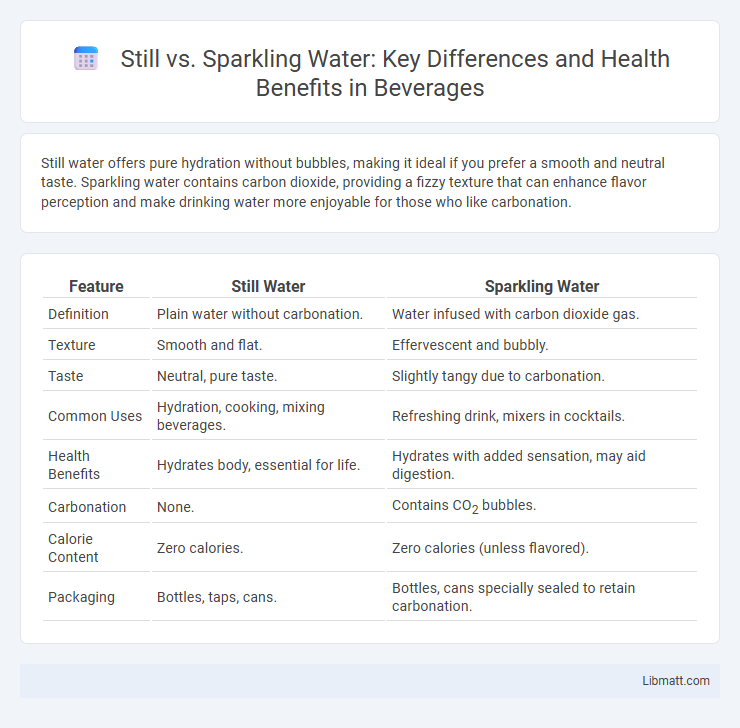Still water offers pure hydration without bubbles, making it ideal if you prefer a smooth and neutral taste. Sparkling water contains carbon dioxide, providing a fizzy texture that can enhance flavor perception and make drinking water more enjoyable for those who like carbonation.
Table of Comparison
| Feature | Still Water | Sparkling Water |
|---|---|---|
| Definition | Plain water without carbonation. | Water infused with carbon dioxide gas. |
| Texture | Smooth and flat. | Effervescent and bubbly. |
| Taste | Neutral, pure taste. | Slightly tangy due to carbonation. |
| Common Uses | Hydration, cooking, mixing beverages. | Refreshing drink, mixers in cocktails. |
| Health Benefits | Hydrates body, essential for life. | Hydrates with added sensation, may aid digestion. |
| Carbonation | None. | Contains CO2 bubbles. |
| Calorie Content | Zero calories. | Zero calories (unless flavored). |
| Packaging | Bottles, taps, cans. | Bottles, cans specially sealed to retain carbonation. |
Introduction to Still and Sparkling Water
Still water, characterized by its absence of carbonation, offers a pure and natural hydration option commonly sourced from springs or purified municipal supplies. Sparkling water contains dissolved carbon dioxide gas, creating effervescence that enhances its sensory appeal and is often mineral-rich, originating from natural springs or artificially carbonated. Both types provide essential hydration but differ significantly in taste, texture, and potential digestive benefits.
What Is Still Water?
Still water, also known as flat water, is natural or purified water that contains no carbonation or bubbles. It is commonly sourced from springs, wells, or purified through filtration processes, making it ideal for hydration without added flavors or effervescence. Your preference for still water supports smooth digestion and is often recommended for daily consumption due to its pure, natural taste.
What Is Sparkling Water?
Sparkling water is carbonated water infused with dissolved carbon dioxide gas, creating its characteristic bubbles and effervescence. It comes in various forms, including naturally carbonated mineral water and artificially carbonated filtered water. This carbonation process gives sparkling water a distinct texture and taste, differentiating it from still water, which contains no dissolved gases.
Key Differences Between Still and Sparkling Water
Still water is naturally free of carbonation, offering a smooth and neutral taste without bubbles, making it ideal for hydration and cooking. Sparkling water contains dissolved carbon dioxide gas, which creates effervescence and a tangy sensation, often enhancing the flavor experience and aiding digestion. The mineral content in both types varies, but sparkling water typically has higher levels of sodium and bicarbonates, contributing to its distinct mouthfeel and potential health benefits.
Health Benefits of Still Water
Still water supports hydration without added carbonation, which can benefit digestion and reduce bloating. It aids kidney function by helping to flush out toxins and maintain electrolyte balance. Your body absorbs still water more quickly, promoting efficient nutrient transport and overall cellular health.
Health Benefits of Sparkling Water
Sparkling water offers hydration benefits similar to still water while providing a refreshing alternative that can aid digestion and reduce constipation due to its carbonation. It may also help increase feelings of fullness, supporting weight management by curbing appetite. Incorporating sparkling water into Your daily routine can enhance hydration without added sugars or calories, making it a healthy beverage choice.
Taste and Texture Comparison
Still water offers a smooth, pure taste with a clean, flat texture that highlights its natural minerals and absence of bubbles. Sparkling water features a crisp, effervescent sensation created by carbon dioxide, providing a tingling texture that enhances flavor perception and refreshes the palate. Your choice between still and sparkling water depends on whether you prefer a gentle, calm drinking experience or a lively, bubbly taste sensation.
Environmental Impact: Bottled Still vs Sparkling Water
Bottled still water typically has a lower carbon footprint than sparkling water due to the absence of CO2 injection, which increases energy consumption and emissions during production. Your choice between still and sparkling bottled water affects plastic waste, as both often use similar PET bottles, though some brands offer recyclable or biodegradable options. Considering environmental impact, opting for locally sourced still water in recyclable packaging can significantly reduce your ecological footprint.
Popular Uses of Still and Sparkling Water
Still water is commonly used for hydration during workouts, cooking, and as a basic refreshment due to its neutral taste and lack of carbonation. Sparkling water is popular as a sophisticated alternative to sodas in social settings, paired with meals to enhance flavors, and used in mixed drinks and cocktails for added effervescence. Both types cater to different preferences, with still water preferred for daily hydration and sparkling water favored for its bubbly texture and sensory experience.
Which Should You Choose: Still or Sparkling Water?
Choosing between still and sparkling water depends on your personal preferences and health considerations. Still water is ideal for hydration without added acidity, while sparkling water offers a refreshing, fizzy alternative that can aid digestion but may cause bloating for some individuals. Your choice should balance taste preference, digestive comfort, and overall hydration needs.
Still vs sparkling water Infographic

 libmatt.com
libmatt.com